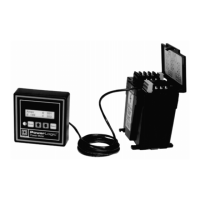Power Meter Bulletin No. 3020IM9503R6/98
Appendix J—Calculating Log File Size December 1998
108 1998 Square D All Rights Reserved
APPENDIX J—CALCULATING LOG FILE SIZE (PM-650 ONLY)
The PM-650 has 1K of memory available for the event log and data log
combined. Using POWERLOGIC software, you can configure the sizes of the
event log and data log within the available memory.
Data is stored in 16-bit registers (16 bits=2 bytes). Since there are 1024 bytes in
1K of memory, there are 512 registers (1024/2) dedicated to logging in the
power meter. Sixteen registers are used by the power meter for memory
management; therefore, 496 registers are available for data logging.
Some quantities that you can log require more registers than others. Cumula-
tive energy readings require 4 registers and non-energy meter readings
require 1 register. Additional registers are required to log the date and time
for each entry. Therefore, the number and type of values you store, and how
often you store those values, affect the rate at which the data logging memory
fills up. Each event log entry uses 8 registers of memory.
This appendix tells how to calculate the approximate size of the log file using
the above information. To see if the log file you’ve set up will fit in the
available logging memory, calculate the size of the log file using the
worksheet below. Your total should not exceed 496 registers.
To calculate the size of the log file, follow these steps:
1. Multiply the number of cumulative energy readings
by 4 (registers): 1. ________
2. Enter the number of non-energy meter readings: 2. ________
3. Add lines 1 and 2: 3. ________
4. Add 3 to the value on line 3 (for date/time of each entry): 4. ________
5. Multiply line 4 by the maximum number of records
in the data log file (how many times you are logging
each quantity): 5. ________
6. Multiply the number of events by 8. 6. ________
7. Add lines 5 and 6. 7. ________
Line 7 should not exceed 496.

